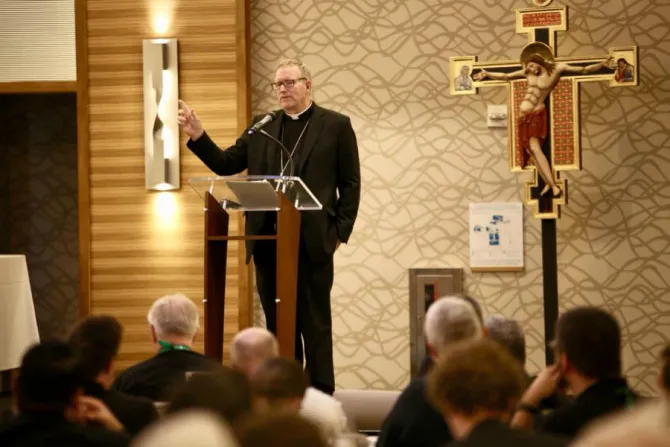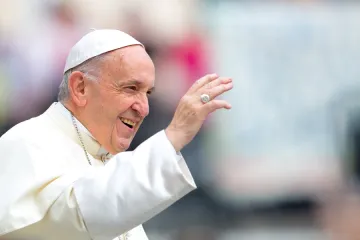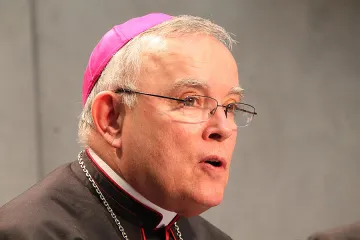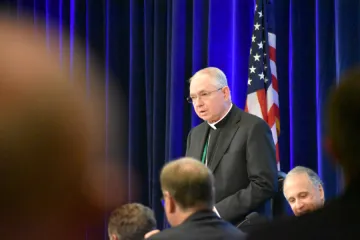Baltimore, Maryland, Nov 12, 2019 / 14:38 pm
Bishop Robert Barron, auxiliary bishop of Los Angeles and chairman of the US bishops' committee on evangelization, outlined five paths for Church leaders to re-energize the religiously unaffiliated on Monday.
Barron's Nov. 11 presentation was on the opening day of the USCCB's Fall General Assembly, held in Baltimore. His presentation opened with a trailer for a new video that fully expands on how better to reach the religiously unaffiliated.
To better engage people who are not affiliated with any religion or who may be fallen-away Catholics, Barron said that the transcendentals – truth, goodness, and beauty – must be communicated to young people in order to pique their interest in religion. Barron presented five strategies and techniques that can be deployed in order to communicate these concepts to young people and the religiously unaffiliated.
These strategies highlight the Church's teachings on justice, her beauty, her intellectualism, her missionary mission, as well as encouraging "creative use of the new media."
Young people, said Barron, do not respond well to some of Catholicism's teachings – particularly those on sex. What they do seem to appreciate, however, is the Church's teachings on social justice. Barron suggested that it could be effective to lead with the Church's teachings on social justice, referring to this as the "path of justice."
"We have a very powerful tradition around doing the works of justice. And young people like that. They get it," said Barron. He cited figures such as Dorothy Day, Thomas Merton, and St. Teresa of Calcutta as figures who have lived out Church teachings of social justice who should be held up as examples to the young people of today.
"We know this tradition. We should propagate it," he said.
Barron said it was important to flex the beauty of the Church to young people, in what he called "Via Pulchritudinis," or "The Way of Beauty."
This beauty, said Barron, extends to more than just physical church buildings. There must also be beauty present in liturgies, as well as in things such as websites – where young people may first encounter their local parish. Barron stressed the importance of having a parish having a solid online presence, as well as engaging Catholic artists and writers and promoting their work.
"Beauty," said Barron "is a great path to follow."
Shifting gears to what he called the "intellectual path," Barron was critical in how he believes the faith was currently being pitched to young people.
"We have to stop dumbing down the faith," he said. He said there has been two generations of a "pastoral disaster" of bad formation, where key tenets of the faith were not effectively taught to young people.
This failure, said Barron, has led to people being unable to properly answer the tough questions that may be asked. When these questions go unanswered, said Barron, people may abandon faith altogether.
Despite what Barron called a "smart tradition" of Catholicism, he said it has not been properly articulated to young people through catechesis. He stressed the need for Catholic schools to better prepare their students so they are fully equipped to enter the next stage of life being able to properly defend the faith and answer those tough questions.
Next, Barron detailed his belief that it would be beneficial to "turn every parish into a missionary society," to seek to better evangelize with young people and the religiously unaffiliated.
Barron said there must be "a dialogue with our priests and our people" regarding evangelization. He called for a change in mindset, and said that all parishes should be reaching out to the community with evangelization and mission work in mind. Parishes should "knock down the walls," said Barron, and interact with the surrounding area.
(Story continues below)
"The young people aren't going to come to us," said Barron. "We have to go out to them."
To properly execute these various techniques and strategies, Barron said priests, bishops, and parishes must embrace a "creative use of new media," namely, social media platforms such as Reddit, Twitter, YouTube, and Facebook.
Social media is the "prime tool" to reach the young people, said Barron. He noted that young people are easily reached through social media, which are platforms that did not exist even a decade ago. The Church needs to embrace social media, which are platforms that can easily and simply reach large amounts of people, in order to reach into the world of young people, said Barron.
"It's a tool that we can and should use to reach out to this world," said Barron. He said that social media has a "sticky" quality about it that can draw in a user to continue to consume content. He cited an example of someone who came to embrace Catholicism after finding Barron's videos regarding Bob Dylan and religion, which led to the person watching more and more videos on the Church.
The Church, said Barron, must invest in this, as well as hire "really good people" to work on social media.
After all, said the bishop, "young people live" online, and they must be reached where they can be found.
"Now we want to get them to parishes," he said, "but as a first step, I think that's one way to do it."






